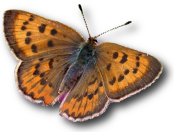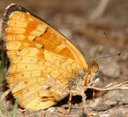 Art Shapiro's Butterfly Site
Art Shapiro's Butterfly Site
Monitoring butterfly populations across Central California for more than 35 years… Phyciodes campestris campestris
Common Name: Field Crescent

The low-altitude subspecies of P. campestris (also called P. pratensis and P. pulchellus) occurs in local colonies in the Sacramento Valley and Delta and in the Coast Range, but only barely ascends the Sierran West slope. It is "capped" by a "no man's land" where no members of the species occur, and above that the endemic montane P. c. montana. Nominate campestris and montana intergrade in the Feather River Country (formerly including Sierra Valley). The campestris phenotype extends from the South Cascades and the High North Coast Range north to the subarctic. In the absence of montana, moreover, it climbs to near tree-line in the Klamath region. This situation deserves further study.
Nominate campestris is double-to-triple brooded on the floor of the Sacramento Valley: normally triple (March-October) but only double in years of persistent flooding in its lowland, usually floodplain or tule marsh, habitat. In such years it may not emerge until June or early July. There was formerly a large colony just north of Davis, which now seems to be extinct. On our transect there have been temporary breeding populations at West Sacramento only, with rare strays elsewhere.
At the Suisun Marsh occurs a very richly-colored race, with the medial part of the wing decidedly yellower than the rest. Its occurrence is especially erratic at our Suisun site, where it does not seem to be a permanent resident.
The multivoltine Valley populations have a fairly pronounced seasonal polyphenism; the cold-seasaon ones are more orange above with less black than in summer, and the hindwing underside is mottled with brown and sometimes silvered, especially in females.
The host plant is Aster, normally the A. chilensis complex (including A. lentus). The eggs are laid in batches and the larvae feed gregariously, at least when young. Adults visit Aster blossoms, but also native Lythrum (Lythraceae), Tall Dogbane (Apocynum cannabinum), thistles and star thistles, etc.

